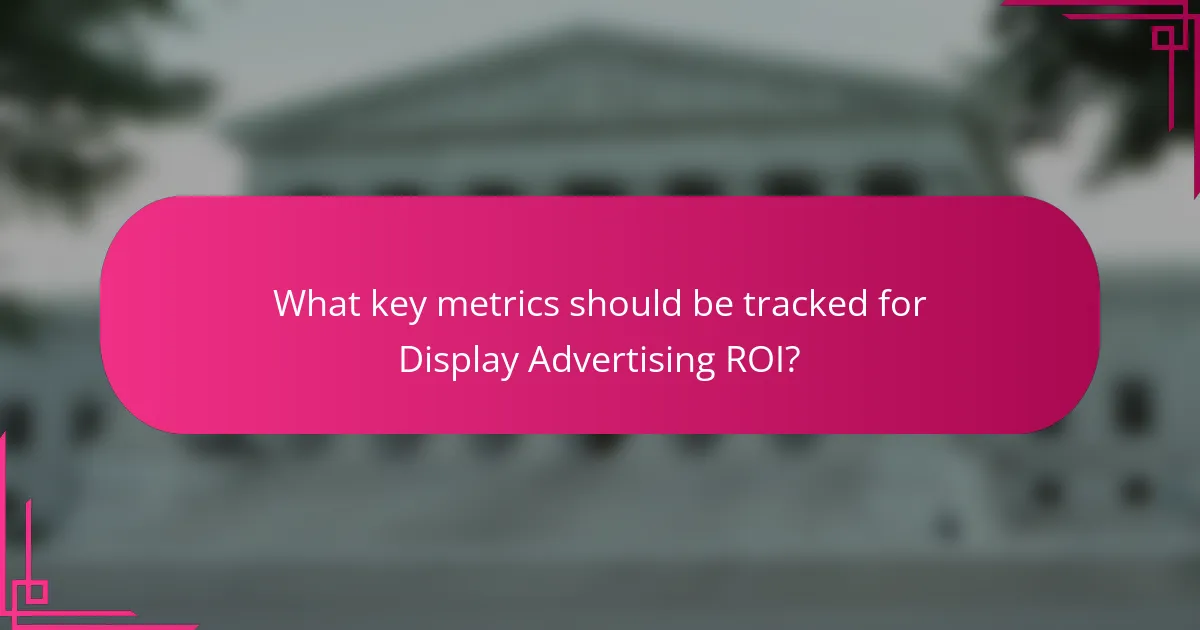Evaluating the Return on Investment (ROI) for display advertising is essential for understanding the effectiveness of ad spend in generating revenue. By analyzing key metrics such as Cost-per-Click (CPC), Click-Through Rate (CTR), and Return on Ad Spend (ROAS), advertisers can gain valuable insights into campaign performance and profitability. This assessment not only helps in measuring success but also guides future advertising strategies to optimize results.

How to evaluate Return on Investment for Display Advertising?
Evaluating Return on Investment (ROI) for display advertising involves analyzing the effectiveness of ad spend in generating revenue. Key metrics such as Cost-per-Click (CPC), Return on Ad Spend (ROAS), and Customer Lifetime Value (CLV) provide insights into the profitability of campaigns.
Cost-per-Click (CPC) Analysis
Cost-per-Click (CPC) analysis measures the cost incurred for each click on a display ad. This metric helps advertisers understand how much they are paying to drive traffic to their website, allowing for budget adjustments based on performance.
A typical CPC can range from a few cents to several dollars, depending on the industry and competition. For example, niche markets may see higher CPCs, while broader markets might have lower costs. Regularly monitoring CPC can help identify underperforming ads that may need optimization.
Return on Ad Spend (ROAS)
Return on Ad Spend (ROAS) calculates the revenue generated for every dollar spent on advertising. This metric is crucial for assessing the effectiveness of display ad campaigns and determining whether they are meeting financial goals.
A favorable ROAS is typically considered to be at least 4:1, meaning that for every dollar spent, four dollars in revenue are generated. Advertisers should track ROAS over time to identify trends and make informed decisions about scaling or adjusting campaigns.
Customer Lifetime Value (CLV)
Customer Lifetime Value (CLV) estimates the total revenue a business can expect from a customer throughout their relationship. Understanding CLV helps advertisers gauge the long-term value of acquiring customers through display advertising.
To calculate CLV, consider factors like average purchase value, purchase frequency, and customer retention rate. A higher CLV indicates that investing in display advertising may yield significant returns over time. Advertisers should aim to align their CLV with their CPC and ROAS to ensure sustainable growth.

What key metrics should be tracked for Display Advertising ROI?
To effectively evaluate the return on investment (ROI) for display advertising, key metrics such as Click-Through Rate (CTR), Conversion Rate, and Impressions and Reach should be tracked. These metrics provide insights into how well your ads are performing and their impact on your overall marketing goals.
Click-Through Rate (CTR)
Click-Through Rate (CTR) measures the percentage of users who click on your ad after seeing it. A higher CTR indicates that your ad is engaging and relevant to your target audience. Generally, a good CTR for display ads ranges from 0.5% to 2%, but this can vary by industry.
To improve CTR, focus on creating compelling ad copy and eye-catching visuals. A/B testing different versions of your ads can help identify which elements resonate best with your audience. Avoid using misleading headlines, as they can lead to high bounce rates and negatively impact your brand’s reputation.
Conversion Rate
The Conversion Rate represents the percentage of users who complete a desired action after clicking on your ad, such as making a purchase or signing up for a newsletter. Tracking this metric helps assess the effectiveness of your ad in driving actual business results. Typical conversion rates for display ads can vary widely, often falling between 1% and 5%.
To enhance conversion rates, ensure that your landing pages are optimized for user experience and aligned with your ad messaging. Consider using clear calls to action and minimizing distractions on the landing page. Regularly analyze user behavior to identify and address any barriers to conversion.
Impressions and Reach
Impressions refer to the total number of times your ad is displayed, while reach indicates the number of unique users who see your ad. Both metrics are crucial for understanding the visibility of your display advertising campaigns. High impressions with low reach may suggest that your ads are being shown repeatedly to the same audience.
When evaluating impressions and reach, consider your campaign goals. If brand awareness is a priority, aim for a higher reach. However, if your focus is on retargeting, higher impressions may be beneficial. Use tools to track these metrics and adjust your targeting strategies accordingly to maximize effectiveness.

How to calculate Return on Investment for Display Advertising?
Calculating Return on Investment (ROI) for display advertising involves assessing the revenue generated from an ad campaign relative to its costs. This metric helps advertisers determine the effectiveness and profitability of their advertising efforts.
Formula for ROI Calculation
The basic formula for calculating ROI is: ROI = (Net Profit / Cost of Investment) x 100. In the context of display advertising, net profit is the revenue generated from the campaign minus the total costs associated with it, including ad spend and any additional expenses.
When applying this formula, ensure you accurately account for all costs and revenues. This includes direct costs like ad placements and indirect costs such as creative development or analytics tools.
Example of ROI Calculation
For instance, if a display advertising campaign costs $5,000 and generates $15,000 in revenue, the net profit would be $10,000. Plugging these numbers into the formula gives: ROI = ($10,000 / $5,000) x 100 = 200%.
This means the campaign returned twice the investment, indicating a successful advertising effort. Always compare your ROI against industry benchmarks to gauge performance effectively.

What are the best practices for maximizing ROI in Display Advertising?
Maximizing ROI in display advertising involves strategic planning and execution focused on audience targeting, creative optimization, and performance analysis. By implementing best practices, advertisers can enhance their effectiveness and achieve better returns on their investment.
Target Audience Segmentation
Target audience segmentation is crucial for maximizing ROI in display advertising. By dividing your audience into distinct groups based on demographics, interests, and behaviors, you can tailor your ads to resonate more effectively with each segment.
Consider using data analytics tools to identify key characteristics of your audience. For instance, segmenting by age, location, or purchasing behavior can help you create more relevant ad content, which often leads to higher engagement rates and conversions.
Common pitfalls include overly broad segmentation or neglecting to update segments based on changing consumer behavior. Regularly review and adjust your segments to ensure they reflect current market trends and audience preferences.
A/B Testing of Ad Creatives
A/B testing of ad creatives is an essential method for optimizing display advertising performance. This approach involves creating two or more variations of an ad and comparing their performance to determine which one yields the highest ROI.
When conducting A/B tests, focus on one variable at a time, such as headlines, images, or call-to-action buttons. This allows for clearer insights into what elements drive better results. Aim for a sample size that is statistically significant to ensure reliable conclusions.
Be cautious of running tests for too short a duration, as this can lead to misleading results. A testing period of at least a few weeks is often recommended to account for variations in user behavior over time.

What tools can assist in measuring Display Advertising ROI?
Several tools can effectively measure the return on investment (ROI) for display advertising, providing insights into performance metrics and audience engagement. Utilizing these tools can help marketers optimize their campaigns and make informed decisions based on data-driven results.
Google Analytics
Google Analytics is a powerful tool for tracking website traffic and user behavior, making it essential for measuring display advertising ROI. By setting up goals and conversion tracking, marketers can see how display ads contribute to overall website performance and user actions.
To get started, link your Google Ads account with Google Analytics. This integration allows you to analyze metrics such as bounce rates, session durations, and conversion rates, which are crucial for understanding the effectiveness of your display campaigns.
Facebook Ads Manager
Facebook Ads Manager provides detailed insights into the performance of display ads on Facebook and Instagram. It allows advertisers to track key metrics such as impressions, clicks, and conversions, helping assess the ROI of their campaigns.
Utilize the breakdown feature to analyze performance by demographics, placements, and devices. This granularity helps identify which audience segments are most responsive, enabling more targeted future campaigns and budget allocation.
AdRoll
AdRoll specializes in retargeting and display advertising, offering tools to measure campaign effectiveness across multiple platforms. It provides insights into customer engagement and conversion rates, which are vital for calculating ROI.
Consider using AdRoll’s reporting features to track metrics like cost per acquisition (CPA) and return on ad spend (ROAS). These metrics help determine the profitability of your campaigns and inform adjustments to improve performance over time.

What are common pitfalls in Display Advertising ROI evaluation?
Common pitfalls in evaluating the return on investment (ROI) for display advertising include overlooking key metrics and failing to consider the full impact of campaigns. These missteps can lead to inaccurate assessments of effectiveness and misguided budget allocations.
Neglecting Attribution Models
Attribution models are crucial for understanding which touchpoints contribute to conversions. Many advertisers neglect to implement robust models, leading to misattribution of ROI to display ads that may not be the primary driver of sales. Without proper attribution, it’s challenging to gauge the true effectiveness of different advertising channels.
Consider using multi-touch attribution to give credit to all interactions along the customer journey. This approach can provide a more accurate picture of how display advertising influences conversions over time.
Ignoring Long-Term Value
Focusing solely on immediate returns can be a significant oversight in display advertising ROI evaluation. Display ads often contribute to brand awareness and customer engagement, which can yield long-term value that isn’t immediately reflected in sales figures. Ignoring this aspect can lead to undervaluing successful campaigns.
To assess long-term value, track metrics such as customer lifetime value (CLV) and brand recall over time. This can help in understanding the sustained impact of display advertising beyond initial conversions, allowing for more informed budget decisions in future campaigns.

What emerging trends impact Display Advertising ROI?
Emerging trends significantly influence the return on investment (ROI) for display advertising by shaping how campaigns are executed and measured. Key trends include the rise of programmatic advertising and the integration of artificial intelligence in ad optimization, both of which can enhance targeting and efficiency.
Programmatic Advertising Growth
Programmatic advertising automates the buying and selling of ad space, allowing for real-time bidding and more precise targeting. This growth leads to increased efficiency and potentially higher ROI as advertisers can reach specific audiences more effectively, reducing wasted impressions.
To maximize the benefits of programmatic advertising, consider setting clear campaign goals and using data analytics to track performance. Avoid common pitfalls like neglecting to optimize bids or failing to analyze audience engagement metrics, which can diminish returns.
AI in Ad Optimization
Artificial intelligence is transforming ad optimization by analyzing vast amounts of data to identify patterns and predict outcomes. This technology can optimize ad placements and creative elements in real-time, improving engagement rates and overall ROI.
When implementing AI in your advertising strategy, focus on integrating machine learning tools that can adapt to changing consumer behaviors. Ensure you regularly review AI-generated insights to refine your campaigns, but be cautious of over-reliance on automation without human oversight, which can lead to misaligned messaging.
